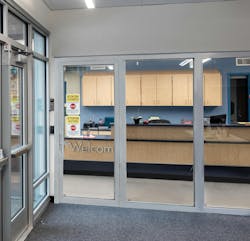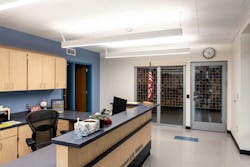Achieving Safer School Design with Secure Entry Vestibules
In 2014, the Partner Alliance for Safer Schools (PASS) brought together several experts in the education community, law enforcement and security industry to develop a comprehensive guide to safer school design. The intent was to create a set of best practices to help schools and architects better plan for emergency events.
The PASS K-12 guidelines take a holistic approach, advocating for the inclusion of multiple layers of security to improve safer school design. Starting with the district layer and moving to the classroom layer, these guidelines address a broad range of threats, providing components that deter, detect or delay and respond to adversarial behaviors. For each layer, the guidelines classify recommendations on a tiered system, with tier 1 establishing a baseline of security and tier 4 representing the highest level of security possible.
Because each school will benefit from different security measures, it is important for designers and administrators to work closely with security professionals to assess which best-practice recommendations will prove the most effective for their building. Among the many tactics, secure entry vestibules are a commonly recommended measure that helps defend schools against violent intruders.
What are secure entry vestibules and how do they support safer school design?
A secure entry vestibule is a small space that leads into the school building or main office. It is secured on either side by doors that have been specified with code-compliant locking hardware. The specifics of this security feature can vary depending on the access control goals of a school. PASS has developed a white paper that outlines common layouts, but it is encouraged that project stakeholders consult with a security expert to determine which design is best suited for the school.
No matter the layout, PASS recommends having a staff member or authorized volunteer visually monitor the vestibule’s intermediate space. Visual assessments can be done remotely via security cameras or directly through security-rated glazing. The ability to assess all visitors is essential to the effectiveness of a secure entry vestibule as it allows monitors time to recognize a threat before physically allowing a person into the building.
While the specifics of a secure entry vestibule’s design can vary, the products and systems used within it can create a barrier between occupants and external threats. As such, they provide administrators time to alert first responders—and for first responders to arrive. They also give students and faculty time to take appropriate actions, such as sheltering in place.
Further, because vestibules can balance access control and free egress, this measure helps designers more readily achieve both security goals and code-driven requirements for exit paths. Given the National Fire Protection Association (NFPA) estimates there are over 3,000 fires per year on school campuses, the protection of egress routes is essential for a comprehensive approach to safer school design. With this in mind, for some vestibule designs, architects may need to incorporate fire-rated materials to achieve code compliance.
To do this, architectural firms have turned to multifunctional, fire-rated glazing assemblies. This type of glazing assembly uses multiple components to guard against physical security threats as well as fire- and life-safety threats. It is crucial that these types of assemblies use compatible components to ensure one form of protection is not compromised for another.
Where does security-rated glass fit into secure entry vestibules?
Though the design of a secure entry vestibule can vary, the main intent stays the same: to improve a school’s ability to control access into the building. A vestibule’s ability to provide such defense is twofold. On the one hand, code-compliant locking hardware and other access control devices keep doors from being opened easily. On the other hand, security-rated glazing reduces weak points in openings to support the ability of locked doors to delay and deter violent intruders.
Whether forced-entry, ballistic-rated or multifunctional, security glazing can enhance entry vestibules by hardening the exterior of a building. They can also act as barriers between the front office and the intermediate space within the vestibule. As such, they support locking devices’ ability to create a barrier between external threats and occupants within the building. Further, transparent security-rated glass can act as a connection between the interior, building perimeter and parking lot layers of safer school design. By uniting these three layers and the various measures in each, security-rated glazing can improve the overall effectiveness of a comprehensive approach to school safety and security.
For example, vestibules with security-rated glazing can establish clear sightlines from the front office through the vestibule into the parking lot. This allows front desk staff to monitor these neighboring areas in real time, which can facilitate a quicker response to incoming threats to buy occupants valuable time to take appropriate action. Likewise, clear sightlines also work with security cameras, CCTV systems and other security equipment to bolster the ability of these systems to detect, delay and deter violent intruders.
Moving inside—other considerations for safer school design
While secure entry vestibules play a crucial role in safer school design, they are not in isolation. To meet best-practice recommendations, school administrators are encouraged to consider multiple layers simultaneously. This approach is crucial because each layer of defense may be called on at different times and in variable order. As noted in PASS and by the International Code Council, school interiors and classrooms are the last layer for external threats but usually provide the first layer of defense for threats already within a building.
Given school violence is often carried out by people with a connection to the school who may be able to bypass building perimeter access controls, it is recommended that the classroom layer is carefully considered in conjunction with other layers. Security-rated glazing can be specified throughout a building to support a multilayered approach to school safety and security. It can be used as vision lites and sidelites in classroom door assemblies to improve the ability of shelter-in-place locations to delay and deter assailants.
It is important to note that improving safer school design may also include considering model and local code requirements. For instance, Chicago-area schools are required to have fire-rated doors along all corridors regardless of the presence of a sprinkler system. This requirement and others like it, may complicate safer school design by requiring materials to provide multiple types of protection simultaneously. In these cases, multifunctional, fire-rated glazing can help designers achieve code-compliant safer school designs.



